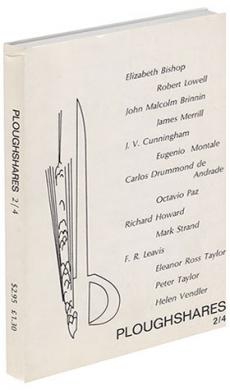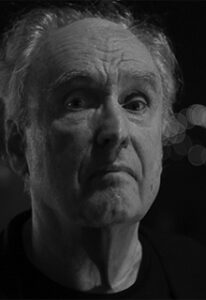rev. of Pity the Monsters: The Political Vision of Robert Lowell by Alan Williamson
Pity the Monsters: The Political Vision of Robert Lowell. By Alan Williamson. New Haven: Yale University Press, 1974.
The very first page of the prefatory material in this new book speaks of Robert Lowell as a moralist, and refers with admiration to something called “moral wisdom,” which we are to ask from poetry. And in the first chapter, the author draws a clear distinction which is at the heart of his book, and which, I think, keeps it from being as good a book as it might have been. Life Studies, says Williamson (writing after the publication of the two Notebooks, but before the appearance of History, For Lizzie and Harriet, and The Dolphin), “is regarded by most of Lowell’s contemporaries as his best book.” Williamson says he “sympathizes” with this judgment, “for I find it his most emotionally moving book.” But Williamson does not really share this judgment, however he may “sympathize” with it, since the “most emotionally moving” poetry is not his highest-ranked genre. Williamson offers as a criticism of Life Studies the judgment that “as the poet struggles to attain an objective view of himself, public judgments become more difficult and relativistic for him, and the prophetic dimension is less in evidence.” In short, Williamson wants “non-relativistic” public judgments, and a prophetic dimension in poetry, needs for his purposes “the barbic or prophetic view of the poet standing above history and perceiving its essential pattern.” (Such a sentence begs the large question of whether history offers any “essential pattern” to our perception, and whether such “standing above history” is anything more than a metaphor for a certain human attitude, inherited from religious symbolism and mediated to us through Milton, but Williamson assumes our assent to his formulations without questioning them.) In this conception of “moral wisdom,” irony and self-doubt are disabilities, and poetry on a human scale is dismissed for something grander:
As Lowell’s ambition [after Life Studies] reaches an epic scale, his poetic voice becomes less ironic, more passionate and authoritative. A conscious grandeur of tone . . . a compelling meter . . . a more richly orchestrated sound . . . [appear].
Though Williamson pays lip service to a recognition of “Lowell’s two modes,” as he names them, and suggests that he chooses between them “on the basis of personal taste,” he never quite suspects that there may not be two modes at all, that they (private irony and public prophecy, to give them his labels) may only be a creation of his own motes or eye-beams, or may at the very least divide a sensibility which through vivid changes preserves nevertheless a vivid singleness and continuity
It is fair to add that Williamson often keeps only a very loose hold on his categories, and becomes absorbed in particular poems, which, to do him credit, he reads in the round, not skewing them to his particular thesis. In one, somewhat limited way, he gives excellent and provocative readings. I have been especially helped by him to understand better, and like better, the poems of Near the Ocean, especially the title poem, “Waking Early Sunday Morning,” and “Fourth of July in Maine.” Quibbles of interpretation are always possible, but on these allusive and oblique poems, Williamson’s comments are on the whole intelligent, learned, balanced, and just. His writing is clear, tough, and straightforward, free of any attempt at mystification: Williamson really wants to make his Lowell, whom he admires and even venerates, clear to the willing but baffled reader. In all these ways the book is a real aid to understanding, and provokes a wish that Williamson would write another book on the striking and perplexing beauties of the revised Notebooks. He knows Lowell’s history well enough to be a welcome guide through the later work. His intellectual contexts of reference are decently gotten up; the book is generally Freudian in its explanation of “unconscious” implication, which is fair enough (though I can’t believe, myself, that Norman O. Brown, to whom Williamson refers as though he were a sage, deserves this reverence).
Williamson’s theory of Lowell’s evolution gives a plausible map for the zig-zags of Lowell’s stance: the early conversion to Roman Catholicism is explained in terms of Lowell’s “desire to see the world reshaped by the force of his visions,” and the rejection of Puritan Protestantism comes from Lowell’s “excessive adolescent hatred” of a system he saw as a “spiritual evil centered on devouring time, predestination, God’s anger, the unreality of this world, and the despicableness of the human body and human motives.” Both religious pre-occupations are replaced by an increasingly “Existentialist” and “Freudian” and “relativistic” view. In two fine compressed chapters on the early poetry and Life Studies, Williamson says many true and well-articulated things:
In so far as insanity is a subject of all the books, the earlier ones give a more vivid sensation of mental loss of control, through their direct presentation of dream, fantasy, and hallucination.
Lord Weary’s Castle . . . claims to be [some say] a Christian book, yet often uses Christian terms as counters . . . for what are essentially issues of family and personal identity. But to argue this would be to beg a question about the general relation between personal and religious experience.
Where that old self [of Lord Weary’s Castle] seemed to be imprisoned in introspection, and to make other people into the symbols of an inner metaphysical drama, the new self cultivates social awareness, observant responsiveness to the surface of life, a dramatic treatment of people’s behavior.
The early formal mastery suggested — often with good reason — an ego rather tyrannously bent on extending its cherished internal rhythms and orders.
And — to choose only one of the many exceptionally good remarks on the strategies of the Notebook poems — here is Williamson on Lowell’s treatment of historical figures:
The thorough application of the psychosexual theme, once a joking tone replaces the usual Freudian solemnity, tends to place all history on the level of an exhibition set up in a brothel. By the sexual emphasis, by the disrespectful familiarity of tone, by the many forms of incongruity, the powerful are reduced to absurd or farcical types: a scaling-down that establishes their common humanity, and even makes us love them, but at an obvious cost to ideology and charisma.
Such confident and authoritative summaries are frequent in Williamson’s book (the best one of them, to my mind, being the analysis of tyrant and tyrannicide in Lowell’s poetry, which appears on pages 100-104).
And yet, and yet. It is perhaps ungrateful to say so, but Williamson doesn’t understand lyric poetry, and he has a tin ear. The tin ear shows up in the infelicites of his own prose, where he uses phrases like “a mind-body separation,” “meaningful correlates of spiritual discovery,” “less prominent symbols,” “a side I have underplayed . . . because I have been concerned with the building up of the image of the hero,” and so on. The Freudian terms sometimes get tangled up in their sentences: “We remember that Jonathan Edwards erred similarly, by misapplying oral metaphores.” Instances of this minor sort could be multiplied. But I am more concerned with a deficiency in Williamson’s sense of what poems are and how they are made and read. Some representative samples of the way williamson writes about the making and reading of poems will give some idea of what I mean.
The “subway-green” flat is a particularly nice detail; it catches a domiciliary impersonality peculiar to New York.
We have seen how craftily water imagery is woven through the last poem.
Similar use is made of less prominent symbols.
This [a passage in “The Quaker Graveyard”] may be taken as the death of God, the revolt of an abused nature, or the dominion of Antichrist, depending on which aspect of the whale symbolism one chooses to emphasize.
This rounds out the pattern of Spanish images.
The dominant s-alliterative becomes the – ess rhyme, but is also blended with more and more dissonant variants ( st-, x-, k-, -tion) until it seems less to croon than to hiss.
Passages like these betray a mind deeply uncomfortable with the part of poetry that is not statement. This obtuseness makes Williamson’s reading of “The Quaker Graveyard” painful to read, as he drags himself obligatorily through its parts: “The central moral theme is set forth . . . From these motives, we proceed . . . In the first lines of the poem, nature . . . appears . . . In the ensuing description Lowell stresses . . . The sea is the most important symbol in the poem . . . Part II replaces the traditional elegist’s Lament of Nature with a kind of rhapsody . . . Here begins a pattern of images . . .” and so on, and so on, down to part VII. Williamson is of course not alone in writing this sort of criticism of a long poem. What is more serious than this plodding dutifulness is a real blindness to the interest of poems as something more than vehicles for “moral themes” or “moral vision,” whether public or private, ironic or prophetic. And I do not mean an interest in the way crooning turns to hissing, or an interest in some putative picture of the Artist at Work, thinking, “Now how craftily can I weave in some water imagery here?” These are the tacked-on utterances of despair, of someone who has been told (and even shown in classrooms) how to “trace the pattern of Spanish images” or “note the alliteration.” Write a passage on moral statement, a passage on imagery-and-symbolism, a passage on rhythm-and-sound: that is how the prescription, so long purveyed in “poetry texts,” goes. Mercifully, Williamson has a sense of his own basic interests and does not bother us too often with the hisses and croons, or craftily rounded-out patterns of Spanish images. Wisely he sticks to his thematic last. He is not very much interested in poetry in general: though there are token mentions of other poets in the book, various allusions that Lowell makes to other poets pass unrecognized (e.g. to Wordsworth in “Long Summer 3,” to Hopkins in “Petit Bourgcois,” to Stevens in “Two Walls,” to Wordsworth again in “Memories of West Street and Lepke”). This in itself is not very serious (and I may be wrong in seeing these allusions myself, since in some cases only Lowell could confirm his own intent), but it stands for a certain blankness that Williamson brings to these poems, which are so much a part of a continuing form of speech in poetry, beginning at least with Milton.
Williamson is also not much interested in what makes these poems beautiful, or even in what makes them poems. Sometimes I feel he would be equally interested in the same sentiments expressed in a well-written essay or autobiography. What this means is that though we have in Williamson a valuable aid to reflection on Lowell, an essential part of Lowell is missing from it — that part which, in public and private poetry alike, will be of interest long after our particular political issues and ideologies are of interest only to historians, long after all the people involved are forgotten. What will be prized then in Lowell will be what we always prize in the dead — the imperishably alive individual voice (whether right or wrong, wise or foolish, prejudiced or disinterested, biogoted or kind, learned or naïf), the private phantasmagoria (whether in details selected from the objective scene or in hallucinatory surrealism), the perfected expression of sensibility in language (whether comic or ironic or tragic or prophetic or nihilistic or sardonic or whatever) — in brief, what Hopkins called “the abrupt rehearsal of self.” In that long view, themes and moral arguments don’t really count much towards survival, though they still need to be understood. The dead poets come to us as ghosts clanking the fetters of their “themes,” more often than not. What will count most for our posterity will be Lowell’s powerful incorporation of all of history into a monstrous metaphor of self, his obsessions, his brutal and tender sight and insight, his long creation of a style so memorable that whatever he writes about takes on life, not from its own inherent moral interest, but merely, and often entirely, from its being expressed in that wholly commanded style. Style includes those elements which Williamson has done so well by here — the poet’s intellectual frame of reference, his moral poles, his varying choice of subject — but poets share these elements with other writers. Lowell’s increasingly pre-eminent place among the poets asks a criticism that distinguishes his specificity as a poet, especially in the remarkable and as yet unassimilated work of the past ten years. But Williamson’s book can be placed with Hugh Staples’ earlier work as a companion to take the reader a good way through this difficult poetry, if not all the way to its inner sources and intimacy of felt experience.



